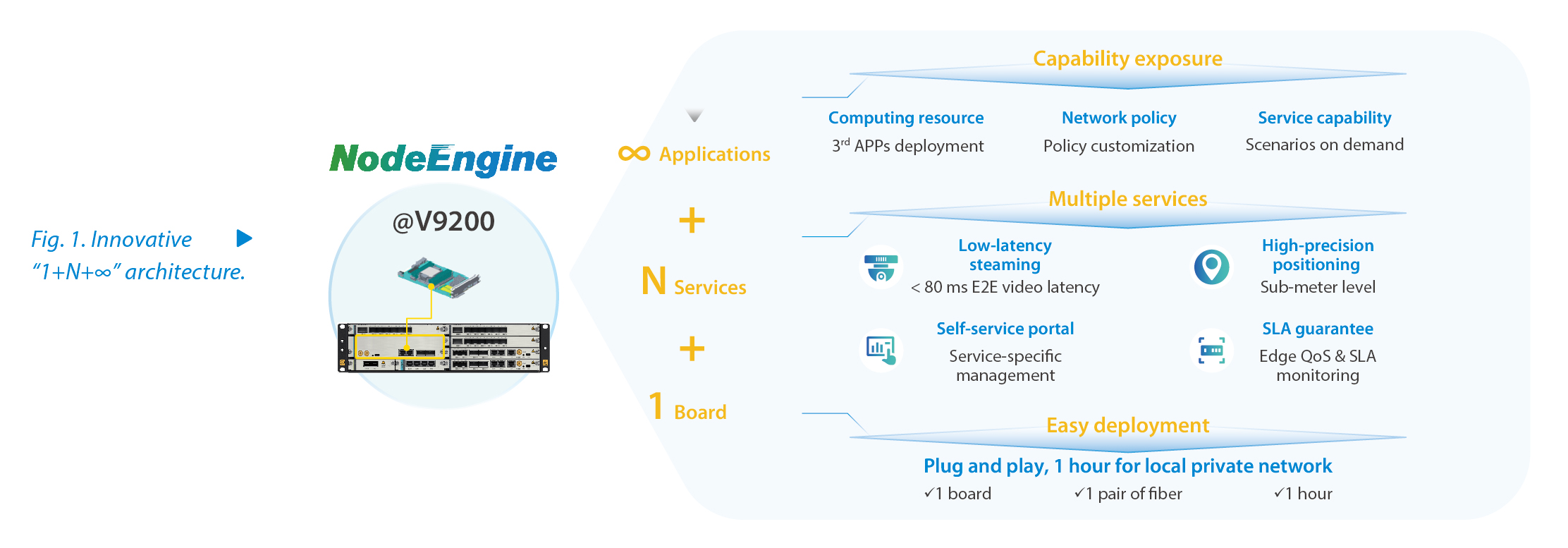5G communication technologies are becoming an important engine for promoting digital transformation of the industry. With the widespread deployment of 5G networks, 5G new products, new services and new business models in the 2B field continue to emerge. The core demand for 5G networks is to meet the needs of industry users for diverse, personalized and economical private network construction. Based on this concept, ZTE has developed its NodeEngine, a unique site-level computing power engine solution. Through the ultra-lean deployment strategy, the solution minimizes the construction of private networks, allowing a large number of small and medium-sized enterprises to build their private networks quickly and economically, and enjoy the benefits brought by 5G. The solution can also support diverse terminals, services and QoS requirements, which provide abundant network functions while realizing intelligent guarantee of service requirements. Moreover, NodeEngine features service capability exposure function, built-in computing power and flexible adaptation to scalable service requirements, laying the foundation for the emerging 5G industry applications and IT/CT/OT convergence.
With the deepening of digital transformation in the 5G industry, customer needs for cloud-network convergence are becoming stronger and stronger. Therefore, leveraging the experience in deploying NodeEngine 1.0 with local traffic offload as the core, ZTE has proposed an innovative "1+N+∞" architecture in NodeEngine 2.0, in which "1" represents a single board (only 1 board is needed to build a plug-and-play local private network), "N" means N-dimensional services that NodeEngine can provide (covering various fields such as low latency videos, high-precision positioning, self-service portal, and SLA guarantee, and providing enhanced service capabilities based on NodeEngine 1.0), and "∞" refers to unlimited expansion of network capabilities through the capability exposure function. As a result, NodeEngine can be built into a new information infrastructure that integrates network connectivity, computing power and capability exposure, making it possible to support an unlimited variety of application scenarios.

Thanks to the leading design of "1+N+∞" architecture, NodeEngine 2.0 realizes ultra-lean network deployment, intelligent network connection and wireless capability exposure in addition to basic capabilities such as no data out of the campus, multi-type terminal access, accurate network capability, self-service and cost-efficiency, so that customer needs can be fully met. The ultra-lean network deployment includes ultra-lean engineering, ultra-lean configuration, and ultra-lean networking.
Ultra-lean engineering can be summarized as "five one", that is, just adding "one single board" on BBU, then implementing connection with existing hardware through "one optical fiber", and finally adding the configuration of "one pair of IP addresses", so that an "one hop access" campus private network can be built within "one hour".
Ultra-lean configuration involves default subscription of blank SIM cards and flexible service allocation. The blank SIM card can be subscribed by default, i.e. be configured through the local self-service portal to establish a mapping relationship with the specific service and provide featured local private network services for the corresponding terminal. The flexible service allocation ensures that the SIM card and CPE can be matched at will, thus greatly improving the flexibility in service deployment.
Ultra-lean networking contains the isolation site autonomy solution that enables 4G/5G convergence and service continuity when the connection to the core network is interrupted and the 5G nomadic base station solution that allows for plug-and-play private services. This considerably reduces the complexity in building a mobile private network.
Intelligent connection guarantee is implemented through intelligent identification, intelligent scheduling, and intelligent orchestration. Intelligent identification can analyze the SLA requirements input by users, and continuously perceive network services. Through AI deep learning algorithm, AI engine and service awareness engine can obtain service types and features, and comprehensively analyze them to get the required network guarantee policy. Then, according to the results of service identification, the system intelligently selects the best scheduling policy and performs closed-loop scheduling optimization in accordance with the results of flow KPI measurement. For the services that do not meet the guarantee goals, intelligent orchestration can also be introduced to implement QoS flow optimization through service peak shifting and service splitting, so as to guarantee fine-grained service SLA and help customers create a “wireless industry brain” that knows more about service features and application scenarios.
In addition, NodeEngine 2.0 supports three capability exposure modes: computing resource exposure, service capability exposure, and network policy exposure. Computing resource exposure means that computation resources and operation environments are opened to support the deployment of third-party industrial APPs. Service capability exposure means that NodeEngine 2.0 native service capability can be opened to the outside according to the needs of users, thus expanding application scenarios on demand. Network policy exposure means that NodeEngine 2.0 can open the policies such as traffic offload, bandwidth management and SLA guarantee to the outside, thus making possible the customized service-level policy orchestration. With these capability exposure functions, NodeEngine 2.0 is no longer a closed system but can fully interact with the cloud side and finally achieve the integration of cloud, network and industry.
The launch of NodeEngine 2.0 has won full recognition from operators and industry customers. So far, NodeEngine 2.0 has been applied in more than 70 projects, covering over 10 industries such as smart mines, smart manufacturing, smart entertainment, smart livelihood and smart medical care. It has helped customers quicly and well build their private networks in various scenarios and achieve good deployment results. The widespread deployment of NodeEngine 2.0 will accelerate the pace of digital transformation of the whole industry, providing better services for various industries.